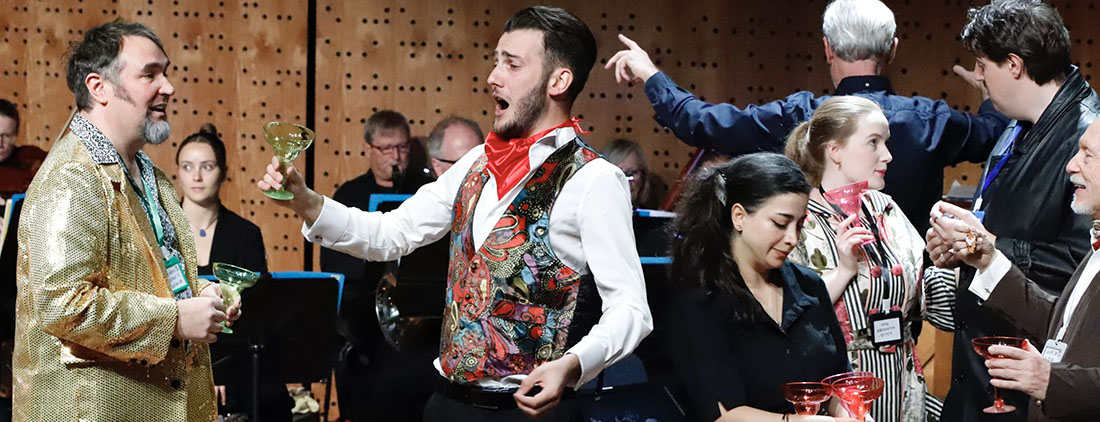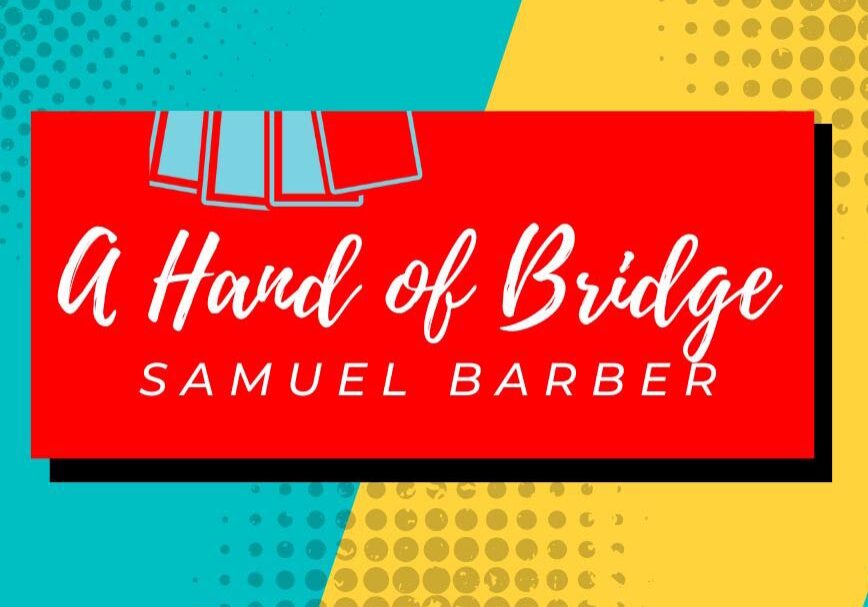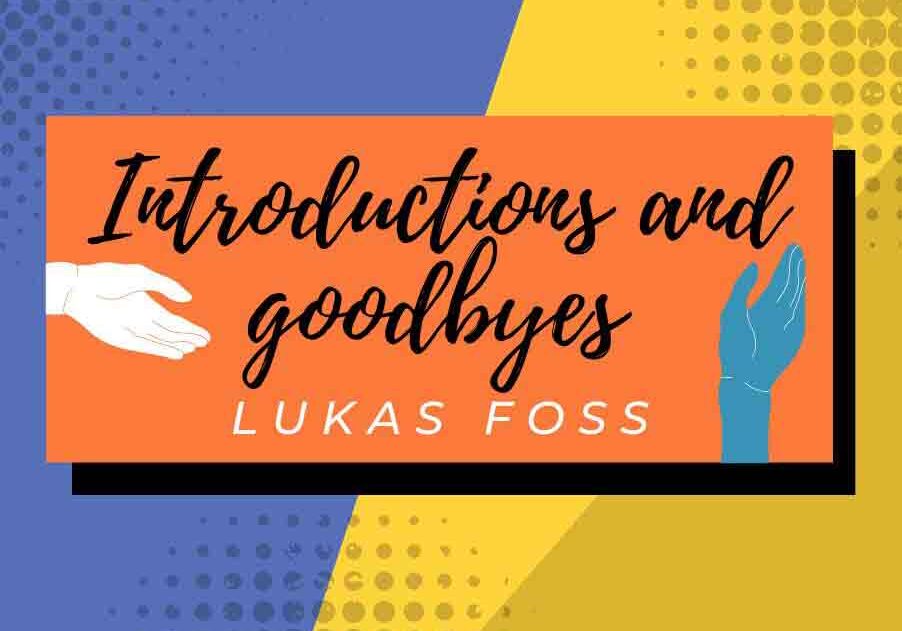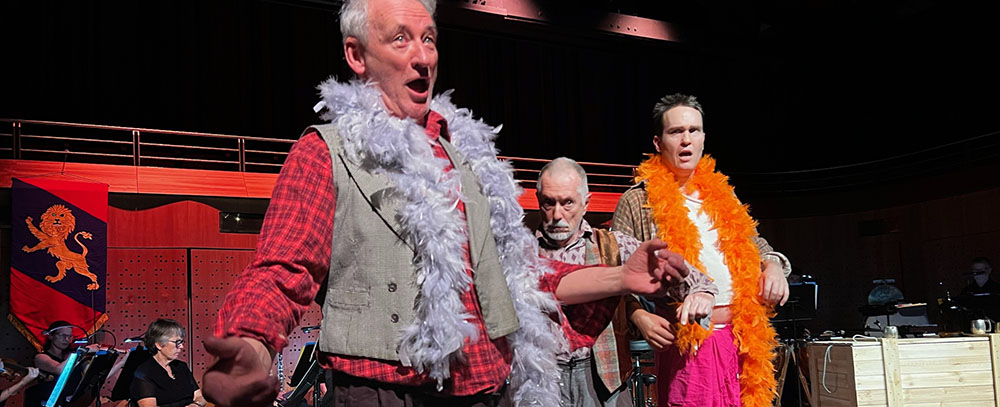17-19 November, 2023: The Neilson, pier 2/3, Sydney
overview:
The production’s title, ‘It’s So Last Century’, really says it all. The performances showcased four operas written within 17 years of each other (1943- 1960) by four composers who each have their own distinct stylistic methods. And it’s SO America versus Germany!
At four performances, our cast of 10 singers and orchestra of 16 musicians, supported by eight back-stage crew, gave their all to bring these four modern operas to thrilling life. Our audiences were delighted.
The first piece ‘Introductions and Goodbyes’ was Lukas Foss’ take on modernism, Manhattan-style. Though employing what Richard Gill called ‘nuts and bolts’ music, Foss allowed a natural inclination toward humour to emerge, including tongue-twisting names and hilariously difficult notes for our baritone, Leon Vitogiannis.
In the second piece, ‘A Hand of Bridge’, composer Samuel Barber combined cool groove with beautifully crafted tunes for the four card players. His uniquely imaginative orchestrations are rarely matched by other composers. In the witty libretto by Gian Carlo Menotti, businessman David (Kent MacIntosh) his wife Geraldine (Emily Turner) lawyer Bill (Ed Suttle) and his wife Sally (Sandra Oldis) each sang their very different secret thoughts, emotions, and desires unheard by the other card players.
The third piece, ‘The Telephone’, was packed full of Menotti’s ingenious musical tricks. Not only a fine opera writer, Menotti stakes his claim as a superb wordsmith. Ben (baritone Matthew Avery) engages in a tussle to gain the attention of his phone-addicted beloved Lucy (soprano Lesley Braithwaite) while the orchestra punctuates the action with florid, beautiful lines.
The final piece was Orff’s ‘Die Kluge’. The music was a mixture of beauty (The Clever One played by Emily Turner); violence (The King played by Matthew Avery); humour and cynicism (explored in a string of comedic characters). The orchestra stayed very busy, often playing notes at the extremes of their ranges. Altogether, the opera provided a unique example of Post-Expressionist bombast and craziness.
Our Conductor, Peter Alexander, arranged the four scores for our 16-piece orchestra. Many of Sydney's best professional musicians played at the performance - an invaluable opportunity for skills exchange for the sprinkling of Sydney Conservatorium students also in the pit. The Modernist flavour of the music gave our two percussionists a welcome chance to strut their stuff!
Guest/Bridge Player/Clever One
Guest/Bridge Player/ 1st vagrant
Guest/Bridge Player
musical team:
Conductor
Viola
Rachel dyker
Oboe/Cor Anglais
Miriam Cooney
Trombone
Harry Macpherson
Concert Master/Violin 1
Cello
Rosemary Quinn
Clarinets
Peter Jenkin
Trumpet
Brian Evans
Repetiteur/Piano
Orchestra Manager
Double Bass
David Cooper
Bassoon
Victoria Grant
Timpani/Percussion
Jack Peggie
Violin 2
Heather Burnley
Flute/Piccolo
Ros Plummer
Horn
Graham Nichols
Percussion
J B Smith

BEHIND THE SCENES:
Artistic Director
Lighting Designer
Julian Dunne
Assistant Director/Crew
Photograpy
Steve Logan
Photography
Greg Thompson
Music Director
Stage Manager
Front of House
Simon Chapman
Photography
Social Media
Sunjot Kaur
Producer
Asst. Stage Manager
Costumes/Props/ Graphics/Program
Video/Photography
Graphics/Crew
Creative Director/ Costumes/Props
Props Manager
Costumes/Props
Emma Slaytor
Photography
Jacky Lawes
With Special Thanks To
Ruth Brent our movement consultant
Aubrey Mellor our mentor
Bianca & Walter
Alis Middleton for her creative insights and practical help
The Unitarian Church for the rehearsal space
Harry Wong for his emergency fixes to the box and props!
The patient Australian Chamber Orchestra staff
Wayne and Gial for videoing the performance
The loan of the Renaissance Players’ banners
Helen Whiteread for her Bridge tutoring

In case you missed it! ----- see the videos
Click here to see videos of the four operas in 'It's So Last Century' here.

Gian Carlo Menotti was the linchpin of three works in our program.
The Italian-born composer, librettist, director and playwright, who made his home in America as a boy, won two Pulitzer Prizes in the course of an illustrious and commercially successful career.
He combined traditional European opera forms and American Modernist sensibilities in his witty reflections on the realities and absurdities of life in the 20th century. Menotti's work gained immense popularity in the '40s, '50s and '60s. He is credited with 25 operas, several having a Broadway run and one being made into a film.
In the fourth work, Carl Orff, presents a profoundly serious fairytale
Both a composer and music educator, Orff is best known for the cantata 'Carmina Burana' (1937). The Carl Orff Foundation describes the work in our program as follows: "in 'Die Kluge' ... he discovered his dramatic style. Terse language is combined with a terse musical style to create a theatrical form of representation which does not illustrate the figures of the work, but sketches them as if with pen and ink."

Menotti wrote both words and music for The Telephone in 1947. He sub-titled it “L’amour à trois”, referring to the triangle between Ben, Lucy, and Lucy’s telephone. The latter constantly thwarts Ben’s attempts to propose to his preoccupied beloved until Ben hits on a clever and pragmatic solution.
The 10-minute one-act opera romance is a tongue-in-cheek nod to the grand opera buffa tradition. Toscanini twice attended the Broadway production and eventually Menotti became a critics' darling and a household name.

A Hand of Bridge is one-act, nine-minute opera, which premiered in 1959. It was composed by Samuel Barber, Menotti’s long-term partner, using Menotti's libretto.
Businessman David and his wife Geraldine, settle in for an evening of cards with lawyer, Bill, and his wife Sally - baritone, soprano, tenor and contralto respectively. While each maintains the ‘poker face’ required by married couples, each sings an arietta monologue that expresses their secrets, desires, longings and laments. The jazz-influenced card theme with swung rhythms threads the four connected stories together.

In 1960, Introductions and Goodbyes, a miniature (ten-minute) opera and 'comedy of manners’ premiered in New York with Leonard Bernstein conducting. We see the cocktail party guests swirl around the hapless and harassed host who sings a "monodrama for baritone" supported by our ensemble of 16 instruments.
Menotti challenged his friend Lukas Foss to compose the music for his tongue-twisting lyrics about the swinging party goers. As star Bette Davis said in the 1950's: "Fasten your seatbelts, it's going to be a bumpy night!"

The longer 1943 work, Die Kluge, is a change of pace. Orff called it a "fairytale opera" but our interpretation put a modern twist on the Grimm Brothers story.
A smart peasant girl wins the heart of a king, is expelled after his foolish ruling on a donkey’s parentage, only to be finally triumphantly reinstated as the ‘clever one’. Three vagrants and a mule man, drawn from the Commedia dell'arte tradition, are the cause of the "clever one's" troubles.

why these particular operas?
A reflection by Artistic Director Christine Logan
One of the delights I enjoy when travelling is going to ‘off-Broadway’ style shows, not only in New York but London, Rome, Tokyo, Phnom Penh, St Petersburg - any city I visit. Intimate, innovative performances interest me more than the proscenium arch blockbusters.
We established Endangered Productions to fill a gap in the Sydney theatre landscape - mounting small-scale productions of rarely-heard Western Art Music operas.
After the success of Peer Gynt, we bounced around ideas and these four works seduced us. Their social commentary and rich musical quality are reminiscent of Mozart’s skill in combining an engaging libretto with great music. Too many new compositions are weighed down with sombre, ‘meaningful’ content which is a deterrent to audiences wanting to enjoy ‘high’ art.
This production wouldn’t have gone ahead without the support of the Carl Orff Foundation in Bavaria. They’re very keen to show the world that Orff is much more than 'Carmina Burana'.
We want Sydney audiences to be enriched by Western Art Music that is witty, wonderful and at times a little wild! This quadruple bill certainly is that.

Creative Approach
Imagination is the stuff of theatre and our approach relies on it!
We wanted the sets/props and costuming to be as minimal as possible; yet even with this intention, we ended up with a man-size box and a chaise longue! Our costuming was a deliberate mix of recycle/reuse/repurpose/borrow and self sufficiency. Our costume store was supplemented by the CD’s clothing vault, especially the coats!
Eventually it worked. The colour, movement and sound took the audience through the boomer period (with a bit of swinger action), to end up in fable and fantasy.
The creative and practical assistance of Shadi Jalinoos was invaluable - from unpacking our new Ultimo home to the mending and making of props, costumes and sets for the show.
Karen Lambert Creative Director

Many Thanks to our local business supporters
Flowers from the Grove
Madame Margo Jewellery
Marion Wheeler Photography
Guardian Family Law
This performance took place on Gadigal land. Always was, always will be.


























